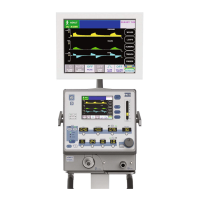regulator and servo valve, the servo valve calibration should be
rerun when either component is replaced. Most of the gas
pressure drops across the servo valves, and gas exiting the servo
valves is close to patient pressure.
Check valves downstream of the servo valves prevent cross-
contamination from the ventilator to the gas supplies.
The flow sensors are hot wire anemometers: as gas flows through
the sensor, it cools the wire and increases its resistance. The flow
sensor adjusts power to keep wire temperature constant, and the
power required is directly proportional to the flow across the wire.
Each flow sensor is factory-calibrated for air or oxygen.
Air and oxygen then enter the mixing chamber
, where they are
combined. The blended gas then exits to the patient circuit through
the inspiratory manifold. The inspiratory manifold also includes the
emergency intake valve and the emergency relief valve. These
components are described above in item 4, Safety Features.
The oxygen sensor is mounted directly to the inspiratory manifold
where it can monitor the delivered F
I
O
2
and compare it to the set
F
I
O
2
. Because the oxygen sensor is sensitive to changes in
atmospheric pressure and temperature, the ventilator calibrates
the oxygen sensor, each time the O
2
3 min button is activated and
any time the monitored F
I
O
2
is >
+ .07 from the set value.
Ventilator software assigns an F
I
O
2
of 1.0 to the voltage read
during calibration. The user may also initiate a calibration from a
menu on the GUI.
During exhalation the inhalation system supplies a bias flow of 3
L/min through the patient circuit to flush exhaled CO
2
and stabilize
temperature, humidity, and baseline pressure. When either Leak
Compensation or Non Invasive is turned On, the ventilator
provides leak compensation by increasing flow above bias flow to
maintain end expiratory flow near 3 liters per minute in the
expiratory flow sensor
.
The maximum leak compensation level
available when Leak Compensation is turned On varies for each
Patient Category as follows: Ped/Infant = 8 L/min, Adult = 15
L/min. Maximum leak compensation supplied by the Non Invasive
function is 25 L/min.
Transducers monitor pressure in the inspiratory manifold and
expiratory system. A transducer re-zero solenoid maintains an
accurate zero point for the pressure transducers by opening
periodically to note the voltage that equals atmospheric (zero)
pressure.
APPENDIX A
SER360 A1106 A-9

